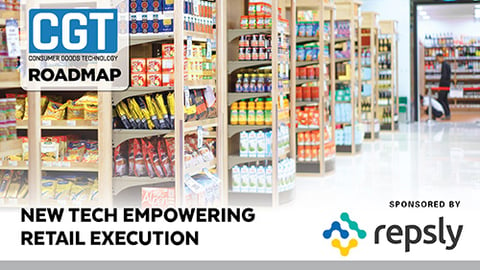Readying Your Retail Execution Teams & Technologies for Tomorrow’s Consumer
High-performing retail execution strategies are crucial for success in today’s selling environment, but many consumer goods companies are saddled with legacy technologies and procedures that are hindering growth. In order to seize market opportunities, platforms need to be both easy to use and adaptable.
We caught up with Peter Billante, chief product officer at Repsly, for the ins and outs when it comes to the challenges of sticking with legacy tech, as well as the signs CGs should look for when it’s time to explore an upgrade.
CGT: How do you know if it’s time to revamp your REX tech stack?
Billante: Your first indication is going to be how quickly you can respond to changes with your retail customers and supply chain. Are you able to quickly adapt your current platform’s workflow and create new programs on-the-fly without custom development or coding, or does every change require a long lead-time IT project and budget? Being “nimbler” in your execution, is what brands need to do to keep pace with competitors and disruptors as highlighted by CGT.
If you’re finding it’s more of the latter, you’re in luck — there are highly adaptable and configurable solutions in the market today that are built on the most up-to-date technology platforms.
Do you hear often from your field teams about how hard it is to use your current application? Today’s business apps are expected to have the same kind of experience as the consumer apps everyone uses today because they don’t require training to use. If your app doesn’t have an Uber or Instagram-like experience, your end users may struggle and not be able to work as fast or be as productive as expected.
If your existing solution hasn’t been updated in a while, that’s a good indication that it’s not getting much attention. There’s an ever-growing set of security threats and reliability expectations to keep your business running, which could lead to significant risk if your platform is getting out-of-date.
CGT: What are the pain points consumer goods companies and retailers have with their current systems?
Billante: Almost everyone will say they need better data because your retail execution strategy is about making a difference in your brand or company’s performance. They want to be able to find problems quickly and address them, communicate changes to the field and customers, and measure performance and compliance.
If your current platform doesn’t provide you visibility into performance in these areas due to gaps in data or accessibility issues, there is good news. You can get up-to-the-minute access to your KPIs, whether it’s the performance of your latest trade promotion event, on-shelf availability metrics, or team productivity and coverage. If you combine that with the ability to link with point-of-sale (POS) data, you can see the impact your programs are having and determine where to direct your future programs for the most uplift.
CGT: What areas should they be investing in today and then in the next two to three years?
Billante: Today and in the next two to three years, consumer goods companies and their retail customers should be investing in ways to create great in-store experiences for consumers. During the past two years, many consumers have adjusted their habits to buy many of their preferred products online.
So, if you’re going to ask a consumer to visit a store, the bar is higher today than it was in 2019. Shoppers need to find the products they want quickly, discover new items that might be of interest, or learn about a product from an expert or display or interaction; otherwise they’ll just buy online for the best price. Cheryl Perkins from InnovationEdge has pointed this out as a key part of a brand’s RetX strategy, in The New Tech Empowering Retail Execution.
One way for consumer goods companies to clear that bar is to ensure their trade promotions are executed correctly in all stores, and the best way to do that is through using a solution that helps guide that process.
CPGs and retailers should look to extend those in-store experiences with new technologies and should look to some of the innovations happening in the sporting goods or cosmetics industry where consumers can virtually experience variations of their products and get a guided selling experience with expert advice. Making sure those programs are done correctly is all part of the retail execution process.
CGT: Once you’ve made the decision to upgrade, what are the next steps?
Billante: First, make sure you’ve created your checklist of “must haves.” Talk to your stakeholders about what you think might be most valuable — what are the business problems you’re trying to address? Rank those from most important to least and start searching for solution providers that match your vision.
Next, form your project team. You’ll always want to make sure you have a team that’s going to be involved in making the decision, such as your internal business partners, company leadership, and your technical or IT points of contact.
Finally, get the demo! There’s nothing like looking at actual software and visualizing how your team might use it. What would their day-in-the-life look like with the new solution? You’ll also want to think about how the software solution might change the way you work today.
One important point to keep in mind — don’t look for solutions that do exactly what you do today or try to replace an old process with a new system. After all, the retail industry does change quickly and trying to just repeat what worked years ago may not make sense in today’s market. Instead, you should look for innovative ideas or improvements, and change the way your teams are working to take advantage of the latest capabilities available.







